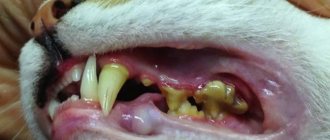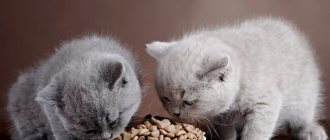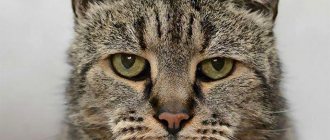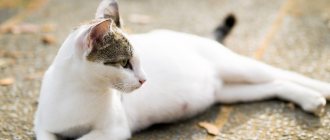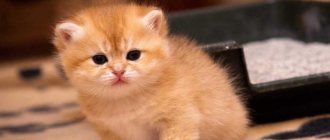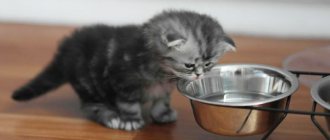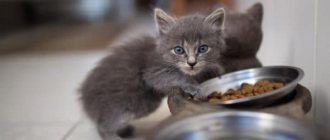There has been a debate among cat owners for many years about which food is better to give to their beloved pet - natural (homemade) or ready-made. Each side has its own arguments. Veterinarians cannot give precise recommendations; they can only share professional advice on selecting ready-made food or creating a menu from natural products.
The main thing is that the animal’s diet is balanced and corresponds to its breed, age, weight, and health characteristics. If preference is given to ready-made food, you should only choose products of at least “premium” class.
High-quality ready-made diets provide the cat with all the necessary substances for growth, development, and excellent coat condition. One of the advantages is ease of feeding . The owner of a pet does not need to buy and prepare fresh food every day; it is enough to pour the prescribed portion into a bowl.
You can get accustomed to ready-made food from a young age, because manufacturers produce special series for kittens. Usually the cat eats appetizing, aromatic food with pleasure. But sometimes cat owners are faced with feeding problems when the cat eats the food offered poorly or refuses it altogether. What to do if the kitten does not eat dry food, what could be the reason?
Benefits of dry food
The cat is considered a capricious animal; moreover, it is a predator, which is more likely to love meat and natural food. And it is not surprising that many pets react with displeasure to the dry food offered.
Small dry granules, even with an attractive smell, bear little resemblance to natural meat and fish. Fewer objections arise from wet cat food, in the form of canned meat or fish. But the pet’s wishes do not always fully correspond to the wishes and capabilities of the owners.
For some reasons, it is more convenient for the owner to use ready-made products than to feed natural food, which needs to be prepared and bought often so that it is fresh and safe. This is usually due to being very busy. Dry food helps out when traveling with an animal or when moving.
ATTENTION! For many diseases, veterinarians recommend ready-made medicinal food.
You can adhere to a prescribed diet of natural products, but without experience, it is difficult for a cat owner to maintain the required balance of elements and calorie content.
High-quality dry food is a worthy alternative to natural products. You just need to combine it with wet food, and don’t forget about the presence of water in the bowl.
And one more rule - careful selection of the manufacturer.
Optimal age to switch a kitten to dry food
The optimal age to switch a kitten to dry food is determined by individual characteristics. The food needs to be soaked until the teeth are completely replaced, since the kitten will not be able to chew the granules and will injure the gums. At normal rates of formation and development, dry food in its “natural” form can be introduced into the diet from 6–7 months of age.
At first, the mass fraction of dry granules in the total daily feed intake should not exceed 10%. After about a week, the amount of dry food increases to 30%. If the kitten confidently absorbs the granules, their mass fraction increases to 50–70% within a few weeks.
Why doesn't the kitten want to eat?
You can introduce dry food to a small kitten.
ATTENTION! You should choose special food for high-quality kittens.
In addition to cats’ natural preference for natural food, there may be other reasons why a small kitten refuses ready-made food:
- Manufacturers try to give ready-made food an appetizing (for cats) aroma. But sometimes they may not guess the taste of a cat - the smell that most kittens like may not suit one.
- It can also cause aversion to the taste of food.
- The cat may simply not feel the desire to eat if not much time has passed since feeding.
- Rejection can be caused by a new type of food, a new brand. After all, only at first glance the compositions seem similar, but if you read the description and list of ingredients carefully, you can find differences.
- The kitten was introduced to ready-made food late. If an animal already has its favorite dishes and is accustomed to a certain menu, it is sometimes difficult to retrain it. The kitten will refuse food for a long time, despite severe hunger.
- The reason for refusing to eat may be a dirty bowl with an unpleasant odor or an expired product. It is not recommended to buy a large bag of food if there is only one small kitten in the house. And even small packaging should be stored correctly.
If a kitten refuses any food, this is a serious cause for concern. You need to show him to a specialist and get tested. A normally developing, healthy baby should have an excellent appetite and good mood.
You should not starve your pet in the expectation that he will give up and still eat the offered dish. Animals, especially cats, are quite sensitive, and reluctance to touch a product may be evidence of an allergy to one of its components.
The kitten is sick
You should really worry only when the kitten refuses any food, not just dry food. As a rule, loss of appetite is accompanied by other symptoms - lethargy, discharge from the nose and eyes, upset bowel movements, vomiting, and fever. In this case, you should definitely consult a doctor.
The most common reasons why a kitten does not want to eat dry food are the whims of the pet and the inappropriate composition of the product. Take these moments seriously, learn to understand dry food and start developing the right eating habits in your baby - then you won’t have any problems feeding your kitten.
What to do
From the very first days of a kitten’s stay in the house, you need to decide what will be more convenient to feed it. If the choice falls on dry food, you need to accustom it to it from an early age. When exactly, you should consult a veterinarian.
If it is not possible to give your pet good premium and super-premium food, then it is better to feed your pet natural food:
- What is the difference between the feeds? Warnings regarding inexpensive feeds have good reason. They consist mainly of cereals, meat, and there are practically no high-quality offal in them. A caring owner will not feed such food to a small kitten, risking its health and even life. Economy class food should only be used as a last resort.
- The premium food group is more suitable for the diet of small kittens. Many manufacturers producing this product also include kitten food in their series. The food already contains more meat and less grains.
- The best option is super-premium ready-made food . Its components are only natural, there are no flavors or dyes.
If you can't spend a lot of money on super premium, you need to find a good premium brand. It is important to combine dry food with canned food. How to properly feed a kitten from the first months of its life can be found out from the veterinarian who is observing the pet.
Manufacturers indicate on the packaging the recommended serving for kittens of a given age; you should definitely follow these recommendations. If overfed, the kitten will quickly recover, but obesity can lead to serious illnesses.
Dry food is usually introduced into the diet at six weeks of age. But it’s better to wait until six months or a year. The period of getting used to such food will take some time, you need to be consistent and not rush. Dry food becomes complementary food, a supplement to milk. The addiction should become gradual.
IMPORTANT! You cannot suddenly change the nutritional system of not only a small kitten, but also an adult.
If a cat owner treats this issue irresponsibly, this can lead to big problems for the animal’s health. At best - diarrhea, vomiting, constipation. The digestive system can be seriously damaged and treatment will be necessary.
When purchasing a kitten from a breeder, owners usually receive a pet that is already accustomed to a certain type of food. You should find out the brand in order to give the animal the same food, at least for the first time.
Kitten does not eat dry food: main reasons
In general, there is only one main reason. Dry food is food that is not physiologically natural for cats. All cats are pronounced predators, and therefore eating dry granules does not cause them much “delight.”
Of course, in practice there may be other reasons for reluctance to eat “packed rations”:
- The kitten does not like the smell or taste.
- The animal is simply well-fed, and therefore pieces of food do not cause an increase in its appetite.
But still, the main reason is the lack of habit of this kind of food. If you don’t accustom him to it right away, then the cat, being already an adult, will not eat it.
How to switch a kitten to dry food (economy, premium, super-premium) without harming the pet’s health
Before switching a kitten to dry food, you must immediately decide what exactly the animal will drink. The quality and purpose of dry food are changeable “matters”.
All products are divided into three main classes:
- Economy As you might guess, when producing “economy” they save on everything. Even if the packaging says something about “meat” in the food, you cannot believe it. Such food contains not only meat, but also sensible offal. The production uses exclusively ground veins, skins, trachea, etc. Cereals serve as a filler. A lot of wheat, corn, in addition to them (as an additional source of protein) soybean meal is used. It is quite logical that this should not be fed to a small kitten. Such food will not provide any benefit to his health. In addition, if manufacturers of more or less normal food try not to include too many dyes and preservatives in their by-products, then “economy” foods sold by weight are full of such compounds.
- Premium Everything is much better here. These foods actually contain meat. In addition, they contain much less grains and “chemicals”.
- "Super premium" They contain a lot of meat, dyes are only natural (hypothetically), there are almost no grains and flavors.
The ideal option is premium diets. They are not as expensive as “super-premium”, but at the same time they are not outright waste (like economy). Of course, if there is a financial opportunity, it is not forbidden to use “Super-Premium”. This is especially true for “capricious” breeds, which include British cats.
How to train
How to properly accustom a kitten to a ready-made diet? Veterinarians advise following the main rule - introducing new food gradually:
- When the kitten is two months old, you can replace part of its daily diet with dry food, but be sure to soften it first - in water, in broth, in milk.
- You can mix such a “new product” with already familiar food. Over time, the kitten will not perceive it as something alien and suspicious.
- The amount of dry granules gradually increases, this period should take about a month.
- To diversify the diet, you can periodically give natural food, this will also improve the functioning of the digestive system.
- Already at five months, the kitten can only eat ready-made dry food. He must have access to clean and fresh water.
- There should be a day in the week when the pet will eat canned food or natural products.
Why does your pet refuse to eat?
Do you want to know why an animal might not want to eat it? This may happen for the following reasons :
- The cat doesn't eat dry food because she simply doesn't like it. Try changing its brand, not necessarily to a more expensive product. She might be happy to eat the budget option. It all depends on your pet's personal taste preferences. You should not buy large quantities at once. Take a little at a time until you find exactly the one your cat likes.
- The cat stopped eating dry food, although she used to eat it with appetite - maybe she was just tired of the monotonous food. Try giving her canned fish or any liquid food . Pamper your pet with pates and meat purees. The cat refuses to eat dry food, give it wet food. Change the foods on the menu as often as possible, and your pet will always eat with pleasure.
- The cat does not eat dry food well because he does not like the smell and taste. This often happens if pet owners like to pour more food into a bowl than the animal can eat in a day. Over time, the product becomes damp and loses its aroma.
- The cat ate it for a month, and now categorically refuses to do it. Pet owners who prefer to make bulk purchases may encounter a similar problem. By buying packages that are too large, you run the risk of eventually getting a product that is unusable. Due to long-term storage, it can absorb moisture and foreign odors, which will significantly deteriorate its taste.
- Very often cats refuse to eat from dirty dishes . Wash bowls every day. They should always be dry and clean.
- The lack of clean drinking water nearby can prevent a cat from weaning itself from eating dry food. If food gets into it, the animal may refuse to drink. Lack of water in the body can lead to disruptions in the digestive system, which can cause loss of appetite.
- The cat may not eat because he is small and is simply not used to such food yet. It will take patience and time to teach him to do this.
- You fed the animal with food you prepared yourself, and now you have decided to switch it to another type of food. This may cause the pet to protest, manifested by refusing to eat.
- Refusal not only from dry food, but also from any other food can be a symptom of various diseases. Perhaps your pet is sick and needs veterinary care.
Attention to pet health
When introducing a new food, dry type, you should be attentive to how your pet feels. You should monitor what kind of feces the animal has, and whether there are any impurities in the urine. Complications that may occur include constipation and indigestion.
If such complications are detected, you need to stop introducing new food and show the cat to a veterinarian. It will be possible to resume feeding with ready-made food no earlier than after five to six weeks.
You will need to try another brand of food, but it must be high-quality and from a reputable manufacturer.
What do our pets eat?
The cat does not eat dry food. What to do? Most owners prefer to feed their pet this delicacy. Indeed, today there is a large selection of even cat food on display.
As you know, various flavoring additives are added to it in order to attract the pet. But there are always exceptions. Not everyone gets hooked on this type of food. Sometimes a kitten won't eat dry food.
What to do in this case? Let's try to figure it out.
Kitten refuses to eat dry food: reasons
- What is the problem? There are many different reasons why a kitten will not eat dry food. The first reason is the simplest: he simply doesn’t like it. Not all cats like this or that food.
- Some prefer one, some prefer the other. To understand which one your cat likes, you need to buy different ones until your pet decides what he likes. You should not buy large packs at once; it is better to buy in small packages.
- It is not known what kind of food a cat will like.
The kitten does not eat dry food. What to do?
- Also, you should not buy food right away at a high price. After all, that’s not the point here at all. If your pet has stopped eating food that he previously consumed with pleasure, then perhaps he has simply become bored with it.
- Have you tried to eat the same thing day after day? So your cat gets tired of it. Give him as many different foods as possible.
- You can combine dry food with wet food, and from time to time even pamper your pet with meat or fish.
Loss of quality
We are not always with our pet. Everyday life requires us to constantly leave and leave. Then you have to give the cat food in reserve. But, as you know, after lying for some time, food loses its original smell and taste.
Your pet may not like it. A similar situation arises when owners buy packages of food that are too large and the cat does not have time to eat everything. As a result, the product deteriorates and no longer meets its taste.
Over a long period of time, it can change its smell or attract moisture.
In order for your cat to always eat with pleasure, his food should be in a clean and dry bowl. A cat is a fairly clean animal. The conclusion is that it is necessary to wash the bowl daily or at least every other day.
The choice of dishes also affects the cat's appetite. You should choose a container that is not deep, but spacious. It is desirable that it be heavy so that the pet cannot knock it over with its paw. Lack of clean water near the food can also cause him to refuse to eat. The thing is that cats simply need clean water. If there are foreign products in it, the animal may not like it.
Lack of water, like in humans, will lead to digestive problems. The kitten refuses to eat dry food. What to do and how to correct errors? Maybe it's worth waiting if he hasn't grown up yet? The animal may not eat food when it's a kitten. His little body is not yet accustomed to such food, especially after his mother’s milk. It’s worth waiting until he grows up and starts eating it himself.
The next reason for an animal to refuse food is a sudden change in food. Let’s say a cat is fed food he has prepared himself, and then they want to switch him to food. Such a solution will most likely not yield results, since the animal is not accustomed to dry food.
There are also more serious reasons when a pet refuses not only dry food, but all food at once. In this case, the development of some disease is possible. A cat cannot tell us what hurts. If you have any suspicions, it is better to immediately take your pet to the veterinarian. Your beloved furry will certainly be helped there.
If your pet has no health problems, then teaching him to eat food is quite possible. All it takes is patience and time. In order to do this as quickly as possible and without unnecessary nerves, it is worth attracting the animal to a new food.
The cat has problems
The cat refuses to eat dry food. What to do and where to go? The most effective option to accustom a kitten to dry food is to gradually add it to the regular food that the animal likes. The important thing is to do this partially and in small portions. This way your pet will begin to gradually get used to the new food.
Then you should slightly increase the amount of dry food. You need to continue until the cat's bowl is 100% filled with dry food. Under no circumstances should you switch directly from regular food to a finished product. Even if the cat likes the new treat. This can be stressful for his digestive system.
How to gradually accustom a cat to dry food?
The entire training process will consist of several stages. First, you should soak the dry food in milk or broth. Of course, clean water will do. But in the first case, the food will be saturated and taste even better.
Secondly, constantly mixing such food with ordinary and familiar ones. And, as mentioned above, its gradual increase. Over time, you can conduct the following experiment.
Place dry food next to regular food, without mixing, and watch the cat’s reaction. If your beloved pet eats both, then the job is done, if not, you should continue in the same way.
If, despite all attempts on your part, the kitten does not want to eat dry food, you should use other methods.
Backup options
It is important to open the briquette with food right in front of the cat. Most animals will be attracted to this and will gobble up the food with interest. There is another interesting method - feeding the cat from your finger. The fact is that many cats will never touch the food in the bowl.
They will lick this same food off their finger with great pleasure. Let’s assume that the animal simply did not taste the food. But finger feeding will help you quickly get used to the food in his bowl. It is even possible to slightly open his mouth so that he can quickly feel the taste of food.
If the kitten does not eat dry food, you now know what to do.
Complete refusal to eat: reasons
It was mentioned a little higher that the reason why a kitten does not eat dry food can be various diseases. This is indeed true. Any owner is concerned about the health of their pet. Therefore, this is also worth stopping at. The condition of a cat when it does not eat is called “feline anorexia.” This only applies to cases where the animal refuses to eat any food.
Diabetes may be the cause. Yes, this can affect not only humans, but also animals. In most cases, appetite returns when sugar levels return to normal. With heart disease, a cat may experience shortness of breath, which leads to difficulty eating.
Olive oil and wet food will help your pet with chronic constipation if it suffers from it. Damage in the mouth and the presence of foreign bodies will also force the cat to refuse even the most delicious food. Dehydration can be a serious problem. In this case, saliva is not released well. Of course, this will lead to starvation.
There are situations when a cat vomits. The cause may be excess toxins and kidney disease.
Everyone knows that a cat will sniff the food before it starts to eat. Inflammation of the airways often leads to loss of smell. As a result, the animal does not touch the contents of the bowl. Cats, like people, can develop dangerous diseases such as cancer. In such cases, immediate treatment is required.
Features of feeding
There are several advantages to feeding dry food:
- It is easy to give the required portion, overfeeding occurs less often. Manufacturers provide a special table of the ratio of portions and weight, the age of the cat.
- Leaving the granules in the bowl for a while will prevent them from spoiling.
- Each manufacturer produces a large number of different types of food. They are intended for different breeds and different ages. There is food with medicinal properties for allergy sufferers.
- If one type of food is not suitable for the kitten, you can try another . The probability of finding the best option is high; a picky person who refuses such food will definitely like some of the food.
Dry or only wet food: misconceptions and reality
According to surveys of veterinarians, 90% of inexperienced (and even experienced) breeders firmly believe that canned food and “natural” food are ideal food for cats, while dry food seems to them almost like waste. But in practice everything is somewhat different.
For some reason, many animal lovers are sincerely confident that food waste from the common table is the most natural “natural”. Of course, it’s better not to talk about the balance of such a diet and its real benefits. In addition, milk and pork, which kind owners often “pamper” kittens with, are generally extremely contraindicated for these animals. Even chicken eggs are not a very healthy food for kittens, since their protein is almost not absorbed by the digestive system of these animals.
In addition, when feeding natural food, the kitten’s diet almost always contains too few vitamins, which must be given separately, in the form of multivitamin supplements. Not everyone knows about this. Finally, kittens need fresh food.
“Natural” soups and offal that have been stored in the refrigerator for more than a week do not really fall under the definition of “fresh”.
As for canned food, everything is completely sad here. High-quality premium and super-premium food is expensive, and cheap food of this type is real poison. We would strongly advise against feeding kittens to her. Unlike canned food, even cheap dry food (oddly enough) is completely balanced in proteins, carbohydrates, fats, microelements and vitamins.
They have other advantages:
- Dry food is very easy to dose depending on the age and weight of the baby. To do this, you just need to use the measurement table, which will definitely be printed on the packaging.
- Pieces of food can be left in the bowl for about a day. They will not deteriorate, will not rot, and will not cause poisoning in the pet. This cannot be done with other types of food, which is especially important for owners who leave home early in the morning and return only closer to night.
- Finally, these types of food are very easy to select based on the individual preferences of the kitten.
